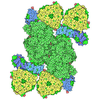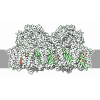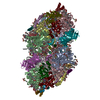+ Open data
Open data
- Basic information
Basic information
| Entry | Database: PDB / ID: 6j40 | |||||||||||||||||||||||||||||||||||||||||||||||||||||||||
|---|---|---|---|---|---|---|---|---|---|---|---|---|---|---|---|---|---|---|---|---|---|---|---|---|---|---|---|---|---|---|---|---|---|---|---|---|---|---|---|---|---|---|---|---|---|---|---|---|---|---|---|---|---|---|---|---|---|---|
| Title | Structure of C2S2M2-type PSII-FCPII supercomplex from diatom | |||||||||||||||||||||||||||||||||||||||||||||||||||||||||
 Components Components |
| |||||||||||||||||||||||||||||||||||||||||||||||||||||||||
 Keywords Keywords | ELECTRON TRANSPORT / Photosystem | |||||||||||||||||||||||||||||||||||||||||||||||||||||||||
| Function / homology |  Function and homology information Function and homology informationthylakoid / photosystem II assembly / photosystem II stabilization / photosystem II / extrinsic component of membrane / phosphate ion binding / photosynthesis, light reaction / chloroplast thylakoid membrane / photosynthesis / respiratory electron transport chain ...thylakoid / photosystem II assembly / photosystem II stabilization / photosystem II / extrinsic component of membrane / phosphate ion binding / photosynthesis, light reaction / chloroplast thylakoid membrane / photosynthesis / respiratory electron transport chain / electron transfer activity / protein stabilization / iron ion binding / heme binding Similarity search - Function | |||||||||||||||||||||||||||||||||||||||||||||||||||||||||
| Biological species |  Chaetoceros gracilis (Diatom) Chaetoceros gracilis (Diatom) | |||||||||||||||||||||||||||||||||||||||||||||||||||||||||
| Method | ELECTRON MICROSCOPY / single particle reconstruction / cryo EM / Resolution: 3.8 Å | |||||||||||||||||||||||||||||||||||||||||||||||||||||||||
 Authors Authors | Nagao, R. / Kato, K. / Shen, J.R. / Miyazaki, N. / Akita, F. | |||||||||||||||||||||||||||||||||||||||||||||||||||||||||
 Citation Citation |  Journal: Nat Plants / Year: 2019 Journal: Nat Plants / Year: 2019Title: Structural basis for energy harvesting and dissipation in a diatom PSII-FCPII supercomplex. Authors: Ryo Nagao / Koji Kato / Takehiro Suzuki / Kentaro Ifuku / Ikuo Uchiyama / Yasuhiro Kashino / Naoshi Dohmae / Seiji Akimoto / Jian-Ren Shen / Naoyuki Miyazaki / Fusamichi Akita /  Abstract: Light-harvesting antenna systems in photosynthetic organisms harvest solar energy and transfer it to the photosynthetic reaction centres to initiate charge-separation and electron-transfer reactions. ...Light-harvesting antenna systems in photosynthetic organisms harvest solar energy and transfer it to the photosynthetic reaction centres to initiate charge-separation and electron-transfer reactions. Diatoms are one of the important groups of oxyphototrophs and possess fucoxanthin chlorophyll a/c-binding proteins (FCPs) as light harvesters. The organization and association pattern of FCP with the photosystem II (PSII) core are unknown. Here we solved the structure of PSII-FCPII supercomplexes isolated from a diatom, Chaetoceros gracilis, by single-particle cryoelectron microscopy. The PSII-FCPII forms a homodimer. In each monomer, two FCP homotetramers and three FCP monomers are associated with one PSII core. The structure reveals a highly complicated protein-pigment network that is different from the green-type light-harvesting apparatus. Comparing these two systems allows the identification of energy transfer and quenching pathways. These findings provide structural insights into not only excitation-energy transfer mechanisms in the diatom PSII-FCPII, but also changes of light harvesters between the red- and green-lineage oxyphototrophs during evolution. | |||||||||||||||||||||||||||||||||||||||||||||||||||||||||
| History |
|
- Structure visualization
Structure visualization
| Movie |
 Movie viewer Movie viewer |
|---|---|
| Structure viewer | Molecule:  Molmil Molmil Jmol/JSmol Jmol/JSmol |
- Downloads & links
Downloads & links
- Download
Download
| PDBx/mmCIF format |  6j40.cif.gz 6j40.cif.gz | 2.1 MB | Display |  PDBx/mmCIF format PDBx/mmCIF format |
|---|---|---|---|---|
| PDB format |  pdb6j40.ent.gz pdb6j40.ent.gz | Display |  PDB format PDB format | |
| PDBx/mmJSON format |  6j40.json.gz 6j40.json.gz | Tree view |  PDBx/mmJSON format PDBx/mmJSON format | |
| Others |  Other downloads Other downloads |
-Validation report
| Summary document |  6j40_validation.pdf.gz 6j40_validation.pdf.gz | 22.6 MB | Display |  wwPDB validaton report wwPDB validaton report |
|---|---|---|---|---|
| Full document |  6j40_full_validation.pdf.gz 6j40_full_validation.pdf.gz | 24.3 MB | Display | |
| Data in XML |  6j40_validation.xml.gz 6j40_validation.xml.gz | 418.9 KB | Display | |
| Data in CIF |  6j40_validation.cif.gz 6j40_validation.cif.gz | 481.7 KB | Display | |
| Arichive directory |  https://data.pdbj.org/pub/pdb/validation_reports/j4/6j40 https://data.pdbj.org/pub/pdb/validation_reports/j4/6j40 ftp://data.pdbj.org/pub/pdb/validation_reports/j4/6j40 ftp://data.pdbj.org/pub/pdb/validation_reports/j4/6j40 | HTTPS FTP |
-Related structure data
| Related structure data |  9777MC  9775C  9776C  6j3yC  6j3zC C: citing same article ( M: map data used to model this data |
|---|---|
| Similar structure data |
- Links
Links
- Assembly
Assembly
| Deposited unit | 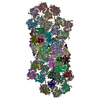
|
|---|---|
| 1 |
|
- Components
Components
+Photosystem II reaction center protein ... , 12 types, 24 molecules AaDdHhIiJjKkLlMmTtYyZzWw
+Photosystem II chlorophyll protein ... , 2 types, 4 molecules BbCc
+Cytochrome b559 subunit ... , 2 types, 4 molecules EeFf
+Extrinsic protein in photosystem ... , 3 types, 6 molecules OoUuQq
+Protein , 2 types, 18 molecules Vv11121314151617183132333435363738
+Protein/peptide , 1 types, 2 molecules Xx
+Unknown protein ... , 3 types, 6 molecules 051627
+Fucoxanthin chlorophyll a/c-binding protein monomer ... , 3 types, 6 molecules 193920402141
+Sugars , 2 types, 10 molecules 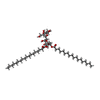
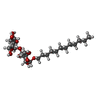

+Non-polymers , 12 types, 478 molecules 
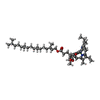

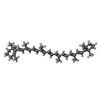
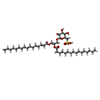
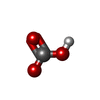
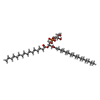
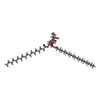

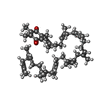

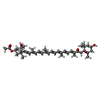











+Details
-Experimental details
-Experiment
| Experiment | Method: ELECTRON MICROSCOPY |
|---|---|
| EM experiment | Aggregation state: PARTICLE / 3D reconstruction method: single particle reconstruction |
- Sample preparation
Sample preparation
| Component | Name: C2S2M2-type PSII-FCPII supercomplex / Type: COMPLEX / Entity ID: #1-#28 / Source: NATURAL | ||||||||||||
|---|---|---|---|---|---|---|---|---|---|---|---|---|---|
| Molecular weight | Value: 1.15 MDa / Experimental value: NO | ||||||||||||
| Source (natural) | Organism:  Chaetoceros gracilis (Diatom) Chaetoceros gracilis (Diatom) | ||||||||||||
| Buffer solution | pH: 6.5 | ||||||||||||
| Buffer component |
| ||||||||||||
| Specimen | Conc.: 0.256 mg/ml / Embedding applied: NO / Shadowing applied: NO / Staining applied: NO / Vitrification applied: YES | ||||||||||||
| Specimen support | Grid material: COPPER / Grid mesh size: 200 divisions/in. / Grid type: Quantifoil R1.2/1.3 | ||||||||||||
| Vitrification | Instrument: FEI VITROBOT MARK IV / Cryogen name: ETHANE / Humidity: 100 % / Chamber temperature: 277 K |
- Electron microscopy imaging
Electron microscopy imaging
| Experimental equipment |  Model: Titan Krios / Image courtesy: FEI Company |
|---|---|
| Microscopy | Model: FEI TITAN KRIOS |
| Electron gun | Electron source:  FIELD EMISSION GUN / Accelerating voltage: 300 kV / Illumination mode: FLOOD BEAM FIELD EMISSION GUN / Accelerating voltage: 300 kV / Illumination mode: FLOOD BEAM |
| Electron lens | Mode: BRIGHT FIELD |
| Image recording | Electron dose: 20 e/Å2 / Film or detector model: FEI FALCON III (4k x 4k) |
- Processing
Processing
| Software | Name: PHENIX / Version: (1.14_3260: phenix.real_space_refine) / Classification: refinement | ||||||||||||||||||||||||||||||||
|---|---|---|---|---|---|---|---|---|---|---|---|---|---|---|---|---|---|---|---|---|---|---|---|---|---|---|---|---|---|---|---|---|---|
| EM software |
| ||||||||||||||||||||||||||||||||
| CTF correction | Type: PHASE FLIPPING AND AMPLITUDE CORRECTION | ||||||||||||||||||||||||||||||||
| Symmetry | Point symmetry: C2 (2 fold cyclic) | ||||||||||||||||||||||||||||||||
| 3D reconstruction | Resolution: 3.8 Å / Resolution method: FSC 0.143 CUT-OFF / Num. of particles: 98936 / Algorithm: FOURIER SPACE / Symmetry type: POINT | ||||||||||||||||||||||||||||||||
| Atomic model building | Protocol: FLEXIBLE FIT / Space: REAL / Target criteria: Correlation coefficient | ||||||||||||||||||||||||||||||||
| Atomic model building |
|
 Movie
Movie Controller
Controller





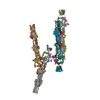

 PDBj
PDBj